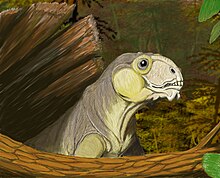| Ulemica Temporal range: Middle Permian, 265 Ma PreꞒ Ꞓ O S D C P T J K Pg N ↓ | |
|---|---|

| |
| Restoration of Ulemica sp. | |
| Scientific classification | |
| Domain: | Eukaryota |
| Kingdom: | Animalia |
| Phylum: | Chordata |
| Clade: | Synapsida |
| Clade: | Therapsida |
| Suborder: | †Anomodontia |
| Infraorder: | †Venyukovioidea |
| Genus: | †Ulemica Ivakhnenko, 1996 |
| Type species | |
| †Venyukovia invisa Efremov, 1940 | |
| Species | |
| |
Ulemica is an extinct genus of venyukovioid therapsids, a type of anomodont related to dicynodonts. It lived during the Middle Permian period in what is now Russia, and is known from the Isheevo assemblage of the Amanakskaya Formation. The type species, U. invisa, was originally placed in the genus Venyukovia by Russian palaeontologist Ivan Efremov in 1940. It was later given its own genus Ulemica in 1996 by Mikhaïl Ivakhnenko, who also named a second species U. efremovi. Efremov had originally intended to name the fossils of U. invisa as 'Myctosuchus invisus', however, he later recognised their similarity to Venyukovia and chose to assign the Isheevo material to this genus and leaving 'Myctosuchus' a nomen nudum.

Ulemica is known from multiple skulls and jaws from individuals of various ages, mostly of U. invisa, while U. efremovi is known only by a single skull. An unusual feature of Ulemica is a pair of prominent bony bosses on each mandible, one at the bottom corner of the chin and another along the bottom edge of the jaw. These bosses are only seen in the largest and presumably oldest individuals.
See also
References
- Ivakhnenko, M. F. (1996). "Primitive anomodonts, venyukoviids, from the Late Permian of Eastern Europe". Paleontological Journal. 30: 575–582.
- Rybczynski, N. (2000). "Cranial anatomy and phylogenetic position of Suminia getmanovi, a basal anomodont (Amniota: Therapsida) from the Late Permian of Eastern Europe". Zoological Journal of the Linnean Society. 130 (3): 329–373. doi:10.1006/zjls.1999.0218.
- Barghusen, H. R. (1976). "Notes on the adductor jaw musculature of Venjukovia, a primitive anomodont therapsid from the Permian of the USSR". Annals of the South African Museum. 69 (10): 249–260. ISBN 0949940933.
- King, G. M. (1994). "The early anomodont Venjukovia and the evolution of the anomodont skull". Journal of Zoology. 232 (4): 651–673. doi:10.1111/j.1469-7998.1994.tb04620.x.
External links
| Taxon identifiers | |
|---|---|
| Ulemica | |
This Anomodont-related article is a stub. You can help Misplaced Pages by expanding it. |





